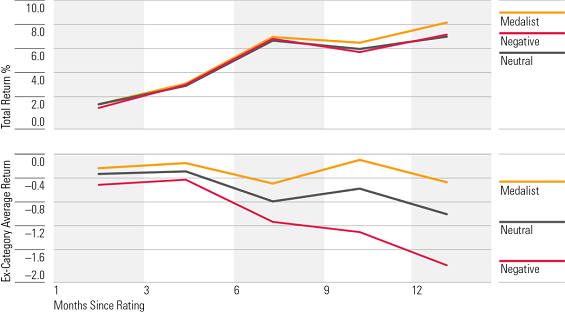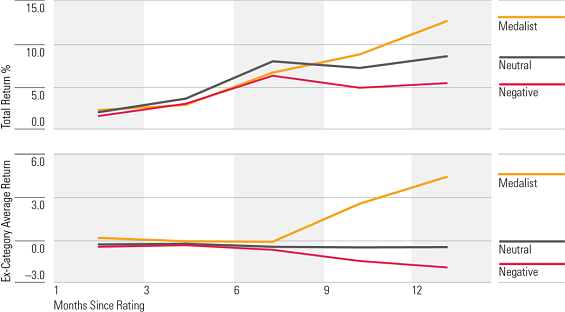Last week, Morningstar rolled out quantitative ratings for Canadian mutual funds, to enlarge the universe of funds under coverage. Quantitative ratings are based on the research and data used by Morningstar analysts in their decision-making process for the Morningstar Analyst Rating for funds.
The scale for the quantitative rating is the same as for Analyst Ratings: gold, silver, bronze, neutral and negative. Funds that receive the quantitative ratings will receive ratings of positive, neutral or negative for each of the five pillars of our analysis: parent, people, performance, price and process. Funds will either receive a Morningstar analyst rating or a quantitative rating, but not both.
This forward-looking assessment is generated after just one month of history, meaning investors no longer need to wait for a fund to rack up a three-year track record to earn a star rating or accumulate enough assets to warrant attention and thus coverage by an analyst.
But does this rating work, and how effective is a forward assessment without historical performance data? To evaluate this, we analyzed the performance of the quantitative ratings from other markets.
Quantitative ratings in the U.S.
In June 2017, Morningstar launched the Morningstar quantitative ratings for funds in the U.S. An analysis of the quantitative and analyst ratings for all funds showed that the Morningstar quantitative rating works, picking clear over- and underperforming funds, even in the absence of performance history.
The figures below show how the recommended rated funds have performed against funds rated negative or neutral. Because of the small sample size of the recommended ratings, the gold, silver and bronze ratings categories have been combined into a single "medalist" group category.
In the first graph, the medalist funds across all categories have outperformed the funds in the negative and neutral groups in terms of total returns. Medalist funds show 12-month cumulative returns of 8.38% compared with 7.44% returns of the funds rated negative over the same period.
The second figure adjusted the medalist group for style and risk, which shows an even more pronounced separation between funds rated as negative, neutral, or as a medalist.

Data as of March 31, 2018. Source: Morningstar
Does the rating work for new launches as well?
In the absence of performance history, the ratings are driven almost entirely by the price and parent pillars. This tends to skew the ratings toward neutral. However, there continues to be a small subset of funds receiving medalist or negative ratings that prove to over- or underperform, respectively.
When looking at the quantitative ratings of all the funds that were launched in the U.S. less than a year before June 2017 -- essentially funds that had no performance information -- the quantitative rating still selected above- and below-average funds.
The first chart below shows the performance of medalist, neutral and negative funds based on the quantitive rating since June 2017 based on total return percentages, while the second chart outlines how the funds rated as per quantitative ratings performed against the category average.

Data as of March 31, 2018. Source: Morningstar
In the year since the Morningstar quantitative rating launched, only 5.6% of share classes of new U.S. funds have been awarded Morningstar medalist ratings. Bronze is the most frequent rating, making up approximately three fourths of the recommended ratings. A gold rating has not yet been awarded to a new fund in the U.S. Conversely, 17% of new funds are rated negative after launch. This make sense, as the main differentiating factors for new funds within the quantitative rating system are the parent and price pillars. If an expensive fund launched from a poorly rated fund company, the fund is likely to be rated negative.
How does this compare to Analyst Ratings?
"The number of funds that receive an Analyst Rating is limited by the size of the Morningstar analyst team," says Morningstar's director of quantitative research Timothy Strauts. "This machine-learning model that we have developed expands the number of funds we cover by using the decision-making processes of our analysts, their past ratings decisions and the data used to support those decisions."
The quantitative rating and the analyst rating are both meant to recommend funds that will outperform over a full market cycle. When compared with funds that had an analyst rating, the quantitative ratings were found to be in-line with the analyst rating, indicating that both are comparable.

By combining the Morningstar Analyst Rating for funds with the Morningstar Quantitative Rating for funds, Morningstar now provides the investor with a complete suite of forward-looking ratings based on analyst-driven research.















